2016 Wildlife Archives: Incredible Findings and Photos
Welcome to the Kiawah Island Nature Program’s wildlife sightings page. Here, you’ll find postings from our Naturalists and island biologists showing you what is currently in the field as well as an archive of observations from throughout the year. We hope this site will get you excited about the amazing and diverse wildlife found on Kiawah. Get outside and share your photos and stories with us at Kiawah_Recreation@KiawahResort.com.
Nov 21, 2016 ~ Fly by at Mingo
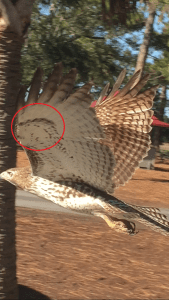 Captain Brad snapped a photo of a hawk flying by the Mingo Point shack with his iPhone! Despite the not-so-red tail feathers on this bird, this is a young Red-tailed Hawk. Red-tailed hawks can look very different from one another based on age, location and time of year. However, the easiest way to identify a Red-tailed Hawk is from the “comma” marks on the wrists of the wings (circled in red).
Captain Brad snapped a photo of a hawk flying by the Mingo Point shack with his iPhone! Despite the not-so-red tail feathers on this bird, this is a young Red-tailed Hawk. Red-tailed hawks can look very different from one another based on age, location and time of year. However, the easiest way to identify a Red-tailed Hawk is from the “comma” marks on the wrists of the wings (circled in red).
There will be lots of hawks and other birds of prey flying around this winter. Stay curious and happy birding!
Oct. 27, 2016 ~ Feather Report: The Butter Butts are Back!
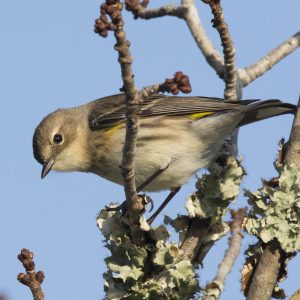 Palm Warbler, Northern Mockingbird, Song Sparrow, Yellow-rumped Warbler, Boat-tailed Grackle, Caspian Tern, Yellow-Throated Warbler, Gray Catbird, Common Gallinule, Great Egret, Snowy Egret, Little Blue Heron, Great Blue Heron, Tri-colored Heron, Pied-billed Grebe, Double-crested Cormorant, Belted Kingfisher, Northern Cardinal, Sharp-shinned Hawk, Clapper Rail, Blue Jay, Fish Crow, Sanderling, Semipalmated Plover, Royal Tern, Sandwich Tern, Forster’s Tern, Black Skimmer, Brown Pelican, Laughing Gull, Ring-billed Gull, Willet, Wood Stork, Bald Eagle, Red-winged Blackbird, Osprey, White Ibis, Tree Swallow, Downy Woodpecker, Red-bellied Woodpecker, Yellow-bellied Sapsucker, Scarlet Tanager, Pine Warbler, White-breasted Nuthatch, Carolina Chickadee, Eastern Phoebe, Carolina Wren, Northern Flicker
Palm Warbler, Northern Mockingbird, Song Sparrow, Yellow-rumped Warbler, Boat-tailed Grackle, Caspian Tern, Yellow-Throated Warbler, Gray Catbird, Common Gallinule, Great Egret, Snowy Egret, Little Blue Heron, Great Blue Heron, Tri-colored Heron, Pied-billed Grebe, Double-crested Cormorant, Belted Kingfisher, Northern Cardinal, Sharp-shinned Hawk, Clapper Rail, Blue Jay, Fish Crow, Sanderling, Semipalmated Plover, Royal Tern, Sandwich Tern, Forster’s Tern, Black Skimmer, Brown Pelican, Laughing Gull, Ring-billed Gull, Willet, Wood Stork, Bald Eagle, Red-winged Blackbird, Osprey, White Ibis, Tree Swallow, Downy Woodpecker, Red-bellied Woodpecker, Yellow-bellied Sapsucker, Scarlet Tanager, Pine Warbler, White-breasted Nuthatch, Carolina Chickadee, Eastern Phoebe, Carolina Wren, Northern Flicker
Reported from Back Island Birding tour lead by Naturalist Juliana Smith
Sept. 30th, 2016 ~ Bird List from Mingo Point
Double-crested Cormorant, Brown Pelican, Great Egret, Tricolored Heron, Green Heron, White Ibis, Turkey Vulture, Clapper Rail, American Oystercatcher, Laughing Gull, Chimney Swift, Ruby-throated Hummingbird, Belted Kingfisher, Red-bellied Woodpecker, Downy Woodpecker, Pileated Woodpecker, Peregrine Falcon, Eastern Wood-Pewee, White-eyed Vireo, Red-eyed Vireo, Blue Jay, crow sp., Carolina Chickadee, Tufted Titmouse, Carolina Wren, Eastern Bluebird, Gray Catbird, Brown Thrasher, Northern Mockingbird, American Redstart, Cape May Warbler, Northern Parula, Yellow Warbler, Black-throated Blue Warbler, Palm Warbler, Pine Warbler, Yellow-throated Warbler, Prairie Warbler, Clay-colored Sparrow, Northern Cardinal, Painted Bunting, Red-winged Blackbird, House Finch
Highlight: Clay Colored Sparrow. A small sparrow that breeds in the Great Plains and winters in south Texas and Mexico. Not a common bird to see on South Carolina’s barrier islands.
May 31, 2016 ~ Atlantic Horseshoe Crab (Limulus polyphemus)
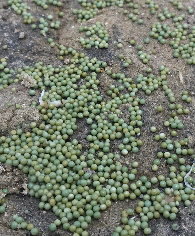 On our Jr. Naturalist Marsh Ecology yesterday, we quite literally stumbled upon some horseshoe crab eggs. Though these eggs had long expired, along with their mother who we found nearby, it was still an incredible experience to actually see the eggs that fuel shorebirds through migration. Red knots, a federally threatened species, depend heavily on the nutrient-rich horseshoe crab eggs to fatten up before making the rigorous flight from our beaches to their breeding grounds in the Arctic. Wow! You never know what you’ll find out there!
On our Jr. Naturalist Marsh Ecology yesterday, we quite literally stumbled upon some horseshoe crab eggs. Though these eggs had long expired, along with their mother who we found nearby, it was still an incredible experience to actually see the eggs that fuel shorebirds through migration. Red knots, a federally threatened species, depend heavily on the nutrient-rich horseshoe crab eggs to fatten up before making the rigorous flight from our beaches to their breeding grounds in the Arctic. Wow! You never know what you’ll find out there!
June 12, 2016
On our Jr. Naturalist Marsh Ecology yesterday, we quite literally stumbled upon some horseshoe crab eggs. Though these eggs had long expired, along with their mother who we found nearby, it was still an incredible experience to actually see the eggs that fuel shorebirds through migration. Red knots, a federally threatened species, depend heavily on the nutrient-rich horseshoe crab eggs to fatten up before making the rigorous flight from our beaches to their breeding grounds in the Arctic. Wow! You never know what you’ll find out there!
May 27, 2016 ~ Swallow-tailed Kite (Elanoides forficatus)
Swallow-tailed Kite reported again today at 1:15pm flying from Turtle Point Golf Course towards the Sanctuary Hotel. Reported by Naturalist Jake Zadick
May 26, 2016 ~ Swallow-tailed Kite (Elanoides forficatus)
At 1:40pm Kiawah Naturalists, Jake Zadick, spotted a Swallow-tailed Kite near the Kiawah Island bridge. A new species for Kiawah’s bird list!
May 25, 2016 ~ Wild Turkey (Meleagris gallopavo)
a mother Wild Turkey and 7 poults have been observed near the Sanctuary. This flock has been seen walking down Sea Forest Drive near the Sanctuary and crossing the Parkway towards the River Course. Please protect our wildlife and use extreme caution while driving on Kiawah.
May 17, 2016 ~ Black-bellied Whistling-Duck (Dendrocygna autumnalis)
8 Black-bellied Whistling Ducks spotted on Turtle Point Golf Course. With their brilliant pink bills and long legs, this is a rare species for Kiawah.
May 11, 2016 ~ Loggerhead Sea Turtle (Caretta caretta)
First sea turtle Nest of the season has been laid.
May 6, 2016 ~ Loggerhead Sea Turtle (Caretta caretta)
Great news! The Turtle Patrol reported today that the first turtle crawl was spotted today near Beachwalker Park. There was no nest but we know the turtles are getting ready….maybe we’ll have a nest for Mother’s Day!
April 17, 2016 ~ Feather Report
Today’s Back Island Feather Report with Naturalist Juliana Smith. 55 species in all! Red-bellied Woodpecker, Blue-gray Gnatcatcher, White-throated Sparrow, Tufted Titmouse, Green Heron, Osprey, Double-crested Cormorant, Pied-billed Grebe, Common Gallinule, American Crow, Red-winged Blackbird, Carolina Wren, Barn Swallow, American Goldfinch, Great-crested Flycatcher, Mourning Dove, Chimney Swift, Yellow-throated Warbler, Pine Warbler, Eastern Bluebird, Carolina Chickadee, Northern Parula, Painted Bunting, Boat-tailed Grackle, Carolina Wren, Northern Cardinal, Cedar Waxwing, Willet, Yellow-rumped Warbler, Brown-headed Nuthatch, Blue Jay, Tree Swallow, Snowy Egret, Great Egret, Great Blue Heron, Tricolored Heron, Lesser/Greater Yellowlegs, Fish Crow, Least Tern, Forster’s Tern, Royal Tern, Gull-billed Tern, Blue-winged Teal, House Finch, Northern Mockingbird, Short-billed Dowitcher, Brown Pelican, Black Skimmer, Bald Eagle, Laughing Gull, Bonaparte’s Gull , Anhinga, Red Knot, Belted Kingfisher, Ruby-crowned Kinglet.
January 26, 2016 ~ Long-Tailed Duck (Clangula hyemalis)
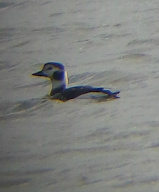 After receiving a hot tip yesterday, my coworker and I set out to explore the beachfront at the Ocean Course in hopes of spotting a female Long-tailed Duck, a lifer for me. Unfortunately, when we arrived, the duck was no where to be seen. Despite her apparent absence, we didn’t give up our search and after about 20 minutes, the duck surfaced for what seemed like the first time since we’d arrived. This isn’t surprising because Long-tailed ducks are some of the deepest divers of all ducks and spend most of their time foraging under the water. Fortunately, we were able to digi-scope a photo of this beautiful bird to share with all of you!
After receiving a hot tip yesterday, my coworker and I set out to explore the beachfront at the Ocean Course in hopes of spotting a female Long-tailed Duck, a lifer for me. Unfortunately, when we arrived, the duck was no where to be seen. Despite her apparent absence, we didn’t give up our search and after about 20 minutes, the duck surfaced for what seemed like the first time since we’d arrived. This isn’t surprising because Long-tailed ducks are some of the deepest divers of all ducks and spend most of their time foraging under the water. Fortunately, we were able to digi-scope a photo of this beautiful bird to share with all of you!
January 22, 2016 ~ Cooper’s Hawk
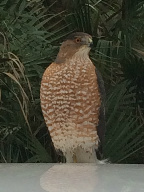 This Cooper’s Hawk was seen yesterday on one of our naturalist’s car at Night Heron. These hawks are fairly common on Kiawah and are known to prey upon other birds such as doves and robins. In order to kill its prey, Cooper’s Hawks will squeeze repeatedly within their talons rather than biting it. Cooper’s Hawks are one of the smallest hawks seen on Kiawah.
This Cooper’s Hawk was seen yesterday on one of our naturalist’s car at Night Heron. These hawks are fairly common on Kiawah and are known to prey upon other birds such as doves and robins. In order to kill its prey, Cooper’s Hawks will squeeze repeatedly within their talons rather than biting it. Cooper’s Hawks are one of the smallest hawks seen on Kiawah.
January 19, 2016 ~ Bald Eagle Pair
From Juliana, one of our Naturalists- This morning’s Back Island Birding tour witnessed Bald Eagles in the throes of mating flight displays. Two pairs of Bald Eagles were seen flying closely in their individual pairs, sometimes seeming as though they would run into each other. Suddenly, a pair locked talons and began to free fall, wings flapping wildly as the eagles tumbled through the air! This lasted for only a few breathless moments, but all who witnessed were awed by the trust eagles have in their life-long mates. This experience alone was well worth the shivering and chill we endured in today’s freezing morning temperatures. Other highlights of the morning: Wood Storks amidst a flock of juvenile White Ibis, a juvenile Red-shouldered Hawk dodging the advances of Blue Jays, and an undulating Anhinga snaking through the chilly waters looking for breakfast.
January 12, 2016 ~ Tundra Swan
Our Back Island Birding tour was surprised by a swan sighting as it gracefully glided over the group on the east end of the island. After some deliberation, it was determined to be a Tundra Swan and, according to the island’s authorities, is likely the first swan sighted from Kiawah Island. The wildlife on the island continues to surprise even our most experienced naturalists! You never know what you’ll get to see!
January 5, 2016 ~ Sunset over the Kiawah River
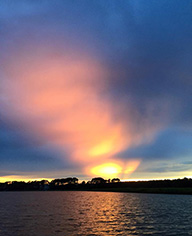 Breathtaking sunset…
Breathtaking sunset…